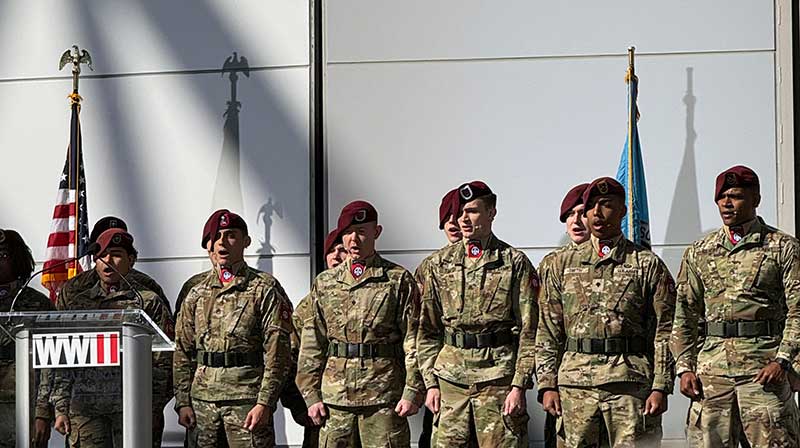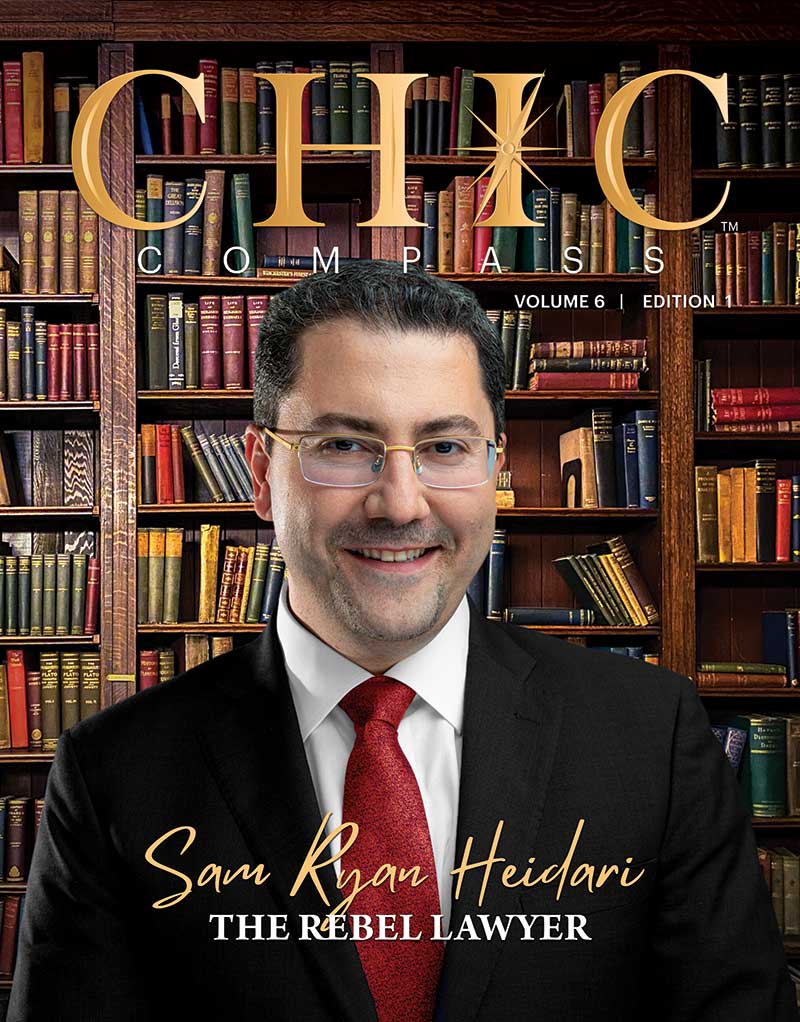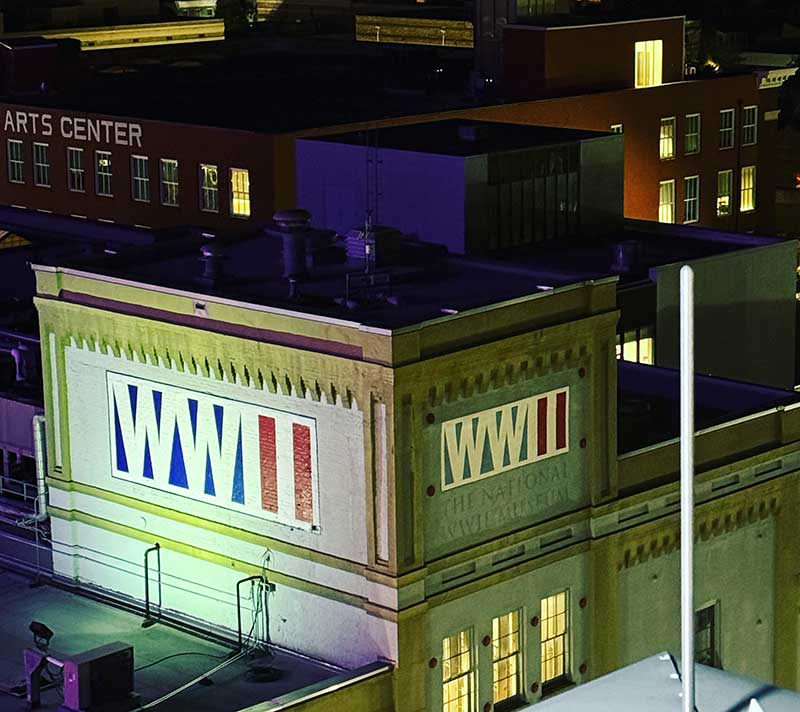
The Liberation Pavilion
The National WWII Museum Opens Its Final Permanent Installation
BY ELAINE & SCOTT HARRIS / PHOTOGRAPHY BY SCOTT HARRIS
New Orleans is a special place known for centuries from all corners of the globe for its culture, culinary excellence, and unique history. However, its number one attraction for locals and visitors is The National WWII Museum, an extraordinary place. It celebrates the final building installment of the Liberation Pavilion. Considered hallowed ground by Veterans and their families, thousands of visitors come to learn, pay respect, and remember those considered the “greatest generation.”
The Museum tells the story of the American experience in the war that changed the world—why it was fought, how it was won, and what it means today—so that all generations will understand the price of freedom and be inspired by what they learn. Dedicated in 2000 as The National D-Day Museum and now designated by Congress as America’s National WWII Museum, it celebrates the American spirit, teamwork, optimism, courage, and sacrifices of the men and women who fought on the battlefront and served on the Home Front.
Recently, more than 40 WWII veterans, Holocaust survivors, and Home Front workers participated in the Grand Opening of The National WWII Museum’s final permanent exhibit hall, Liberation Pavilion, which explores the ongoing relevance of the war and encourages visitors to contemplate the joys, costs, and meaning of liberation and freedom. Over 40 Medal of Honor Recipients and other special guests like Actor Tom Hanks and other dignitaries were on hand for the historic milestone marking the conclusion of the institution’s two-decade journey to expand its campus.
“Nearly 80 years after the end of World War II, we remain ever grateful to those Americans who sacrificed so much to secure freedom and democracy and whose legacies are now our responsibility to carry on here at The National WWII Museum,” said Stephen J. Watson, Museum President, and CEO. “It is an honor to welcome these men and women of the WWII generation to our campus as we celebrate the Museum’s commitment to honoring and sharing their stories. Through the Liberation Pavilion, we will help visitors better understand the human cost of victory and the enduring impacts of World War II today.”
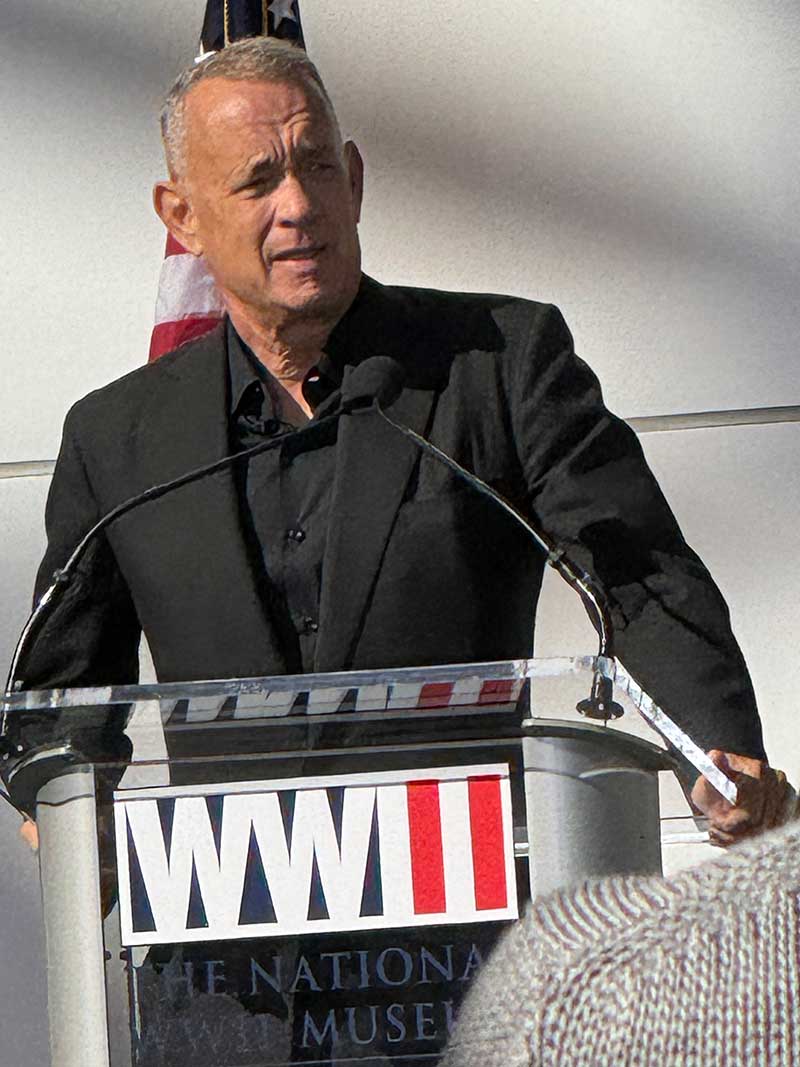
Tom Hanks
On this spectacular November 2023 New Orleans morning, themes of freedom, democracy, and human rights prevailed throughout as Rabbi Bonnie Koppell, the first female rabbi to serve in the US military, gave the invocation, followed by a tribute to the WWII generation by Louisiana Governor John Bel Edwards. Next up was Gold Star Daughter and Museum Trustee Sharon Estill Taylor, Ph.D., who spoke on the loss of her father, US Army Air Forces First Lieutenant Shannon Eugene Estill, during the war—highlighting the steep prices service members and their families paid to ensure victory. The highlight of the day was when actor, producer, director, and writer Tom Hanks took the stage and, with much emotion, reflected on the historic magnitude of the Grand Opening.
The ceremony was a full-circle moment for those who attended the opening of The National D-Day Museum in 2000, including President and CEO Emeritus Gordon H. “Nick” Mueller, Ph.D. He helped found the Museum with his friend, fellow historian, and best-selling author Stephen E. Ambrose, Ph.D. and led the institution until 2017.
“Twenty-three years ago, when we first opened The National D-Day Museum, Steve and I thought we had achieved our goal to preserve and honor the memory of those Americans who fought on the beaches of Normandy in 1944. The accomplishments of the past two decades extend far beyond what we could have imagined, even after we decided to broaden our mission to tell the whole story of the American experience in World War II,” Mueller said. “Hundreds of thousands of Americans made the ultimate sacrifice during World War II, and millions more survived to serve as a beacon for democracy.
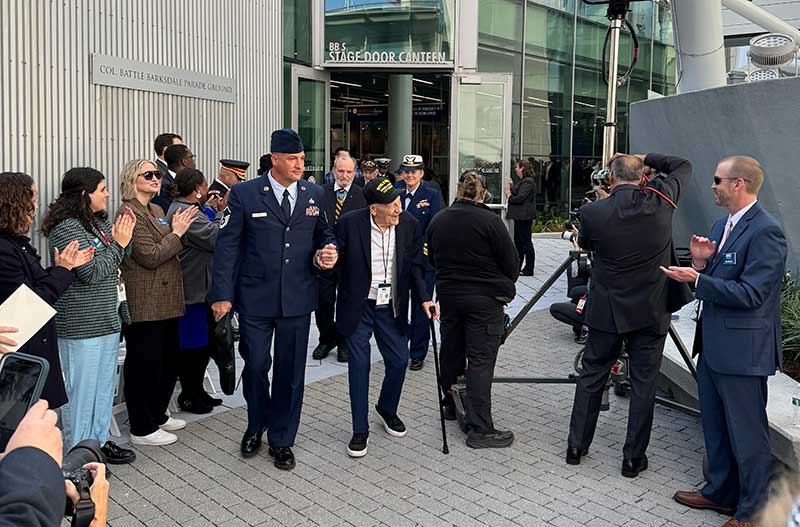
Following years of planning, 2019 commenced the groundbreaking construction of the Liberation Pavilion. Its structure was made possible through the generous support of private donors and the State of Louisiana.
Now, with the opening of Liberation Pavilion, we honor the legacies of the WWII generation and help visitors understand the relevance of the war today — the meaning of the freedom they secured and each generation’s duty to protect and advance it.”
As the Museum’s final permanent exhibit hall, Liberation Pavilion highlights the costs of Allied victory, how the war shaped America and continues to impact our lives today, and the ongoing postwar responsibilities to preserve freedom and defend democracy and human rights. Two stories of exhibit space designed by Gallagher & Associates featuring first-person accounts, iconic imagery, powerful artifacts, immersive environments, and a third-floor cinematic experience explore the end of World War II, the Holocaust, the immediate postwar years, and the war’s continuing impact.
These spaces allow the Museum to tell a complete story of the American experience in the war that changed the world and fulfilled the final pillar of the institution’s mission: What does World War II mean today?
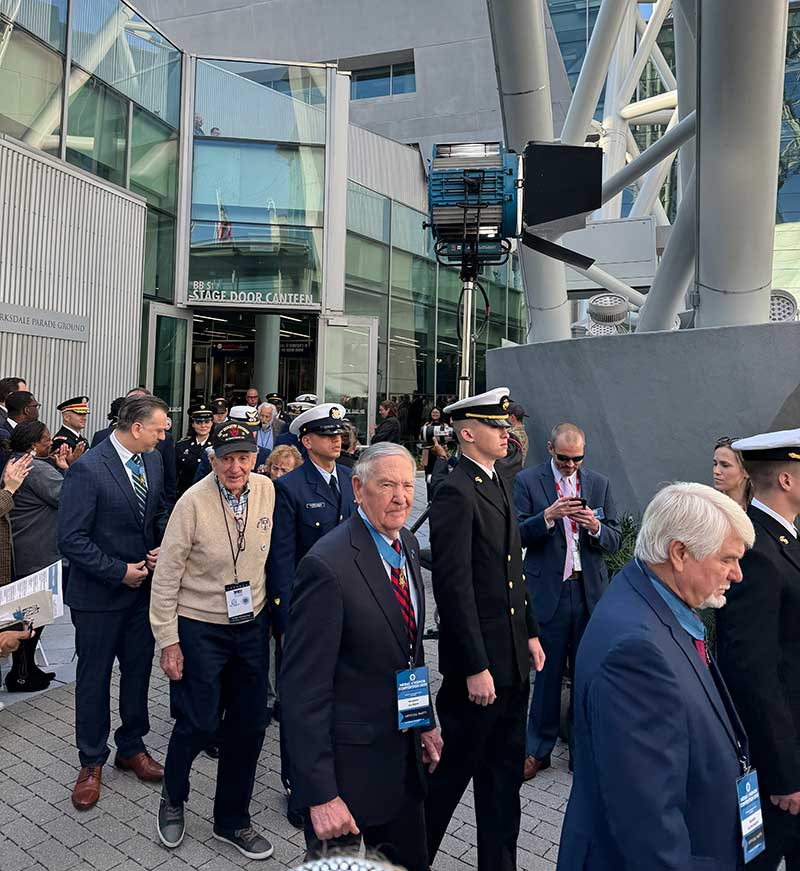
Guests started their experience on the Liberation Pavilion’s first floor, Trott Family Philanthropies, in honor of David W. Trott’s Finding Hope in a World Destroyed. It recognizes the sacrifices of the WWII generation and explores the immense cost of war with exhibits on the Holocaust and then Anne Frank, Faith in Wartime, and the Monuments of Men and Women who served with their lives on the line. Stories of loss and liberation reveal the true horror of the conflict as victors and vanquished alike began rebuilding a shattered world.
On the second floor of the Liberation Pavilion, The Goldring Family Foundation and Woldenberg Foundation Forces of Freedom at Home and Abroad (1945–Present) explore the war’s impact in the postwar period and its lasting legacies today. Exhibits examine the rebuilding efforts of a world destroyed, the war crimes trials, the emergence of the United States as a world “superpower,” movements for social change and civil rights, new technological innovations, and the war’s impact on foreign policy.
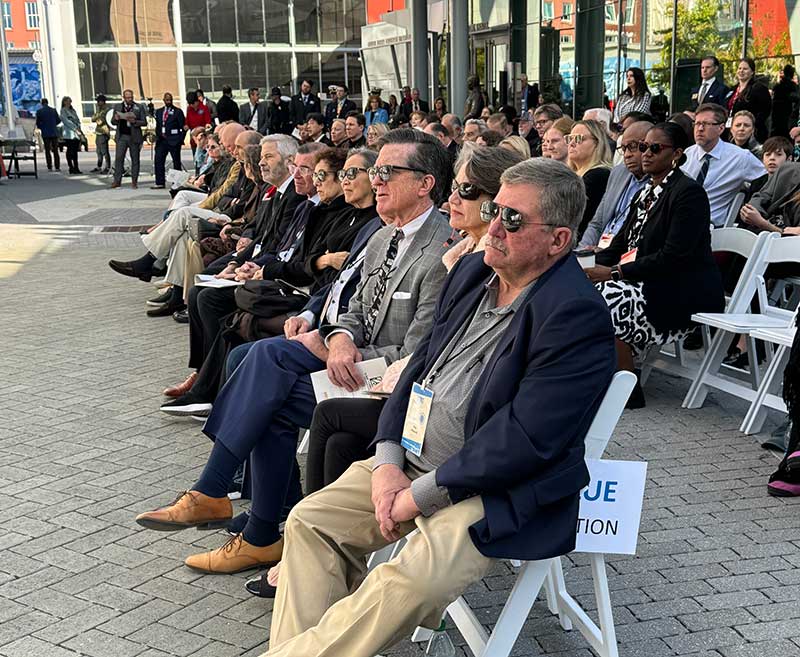
Emotions were high with Veterans who, along with family, took their seats ( many in wheelchairs) at The Priddy Family Foundation Freedom Theater on the third floor of Liberation Pavilion. Offering audiences a multimedia experience focused on what was at stake during World War II and the real meaning of the Allied victory, the production, developed by THG Creative, highlights how freedom almost vanished from the world in the 1930s and 1940s, efforts to protect and promote freedom during and after World War II, and how each generation has a responsibility to defend democracy, protect freedom, and advance human rights. The theater audience’s platform rotates at a pivotal moment in the show, providing an authentic, immersive experience.
In addition, the Museum officially dedicated the 24,000-square-foot Col. Battle Barksdale Parade Ground at the heart of campus, adjacent to the Liberation Pavilion. Its dedication comes almost two decades after the first significant donation to the Museum’s Road to Victory Capital Campaign by Donna and Jim Barksdale. A Museum Trustee earmarked the funds for a future parade ground in honor of his uncle, Colonel Battle Malone Barksdale (1916–2009), a US Army officer in World War II. Barksdale, who witnessed the Japanese attack on Pearl Harbor in 1941 and, in 1944, was sent to the European theater with the 635th Field Artillery Battalion. He later commanded a field artillery battalion in the Korean War. Barksdale retired in 1957 with the rank of Colonel.
“Today is a pivotal day in our institution’s history — the end of an era and the start of a new journey,” said Watson. “As we celebrate, we know that there is much more ahead: We will continue to tell the story of World War II in innovative ways, finding new ways to inspire audiences of all ages across the globe and to embrace our role as storytellers for generations to come.”
The Grand Opening of the Liberation Pavilion and Dedication of the Col. Battle Barksdale Parade Ground marked the successful conclusion of the $400 million Road to Victory Capital Campaign that has driven the growth of The National WWII Museum’s campus and educational programs over the past two decades.
An extraordinary part of the weeklong celebration: The National WWII Museum hosted the Medal of Honor Recipients and their families in New Orleans for the 2023 Congressional Medal of Honor Society Convention, presented by the Stephen G. and Regina Oswald Foundation. During the week, recipients visited select New Orleans-area schools and student gatherings to share stories of courage, commitment, integrity, sacrifice, citizenship, and patriotism.
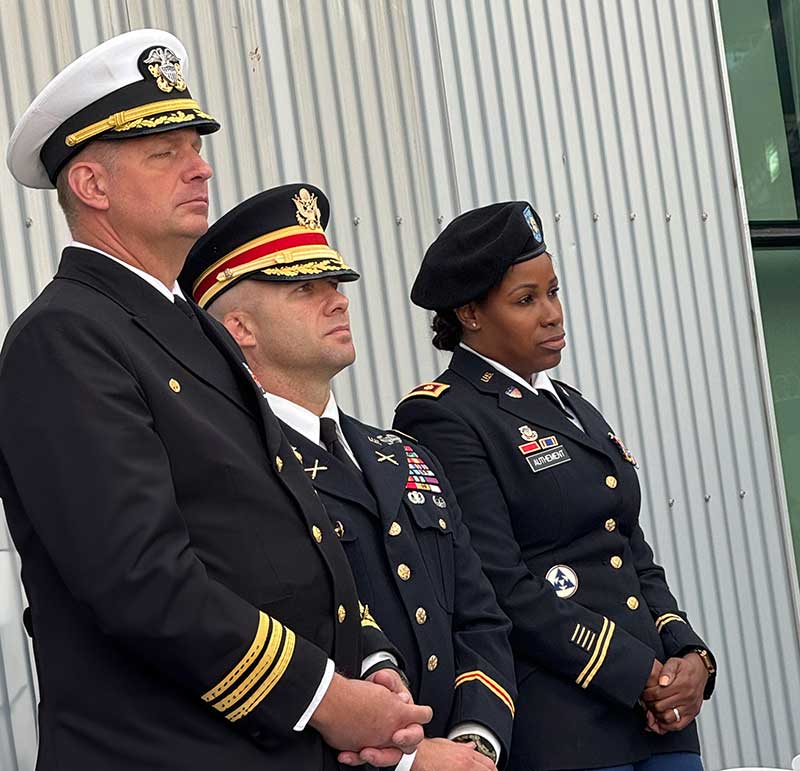
As part of the Congressional Medal of Honor Society’s Character Development Program, these events allowed students to learn how to recognize and exemplify these values while connecting with and asking questions of a Medal of Honor Recipient. Recipients will present each school with a donation on behalf of the Congressional Medal of Honor Society to support their educational mission. The Medal of Honor is the United States’ highest military award for valor, presented to those who have demonstrated gallantry and intrepidity, at the risk of their lives, above and beyond the call of duty.
Having visited the National WWII Museum many times and as a veteran, you should take your time, stop, and take in what you see. Read the personal letters from loved ones shared across many miles under dramatic circumstances, listen to what you are hearing from Holocaust survivors and those who rescued them, and, most importantly, remember what this greatest generation did to preserve liberty during and after WWII.
The perfect way to end a monumental day is a cloudless blue sky in New Orleans while watching the Congressional of Honor Recipients escort WWII Veterans while taking in every word of Tom Hanks’s ending remarks, “The true work of building a perfect union in an imperfect world began the day after the war ended and continues now, and it requires vigilance, it requires attendance, it requires the desire to seek out knowledge, it requires the accumulation of wisdom that will be found by anyone who attends this Museum on any given day or for the rest of time. Hope and Faith lead us to the greatest possibilities in the world that we still cannot even imagine. Hope and Faith and where-with-all and the ongoing attempt to accomplish magnificent things can build a massive campus out of a handful of buildings and some artifacts. It can fuel the efforts of people who, for 30 years, have seen it until its conclusion. It can build a building dedicated to peace and liberty.”
